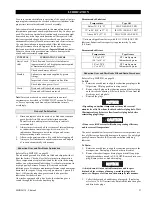
30
MHD56114 - Edition 4
3.
Remove thrust washer (35) and output carrier assembly (36).
4.
Remove the input carrier assembly (42) by grasping the
intermediate sun gear (39) and removing as an assembly. This
also removes the input sun gear (43). Ensure that thrust
bearing (45) and thrust washers (44), located on the end of
the input sun gear (43), are removed.
NOTICE
• Do not disassemble carrier assemblies (36) and (42). Replace
if damaged or worn.
5.
Remove the oil seal (58) and discard. Remove the caged
needle bearing (46) only if replacing. To remove press
bearing out of housing.
Free Spool Disassembly
Refer to Dwg. MHP2414 on page 63.
1.
Relieve pressure in the air lines and winch air components by
operating the winch control several times after the air supply
has been turned off.
WARNING
• Shut off, bleed down and disconnect the air supply line
before performing any disassembly procedures.
• Do not attempt repairs with load on wire rope.
2.
To assist in reassembly, place match marks on the housing
(502) and outboard upright (26).
3.
Remove free spool shifter assembly (507) by pulling it out of
housing (502). This assembly is held in place by ‘O’ ring
(501). Remove and discard ‘O’ ring (501).
4.
Pin (508) and handle (512) are held in position by Loctite
®
applied during assembly. To remove these parts, carefully
heat the shifter (515) until parts are removable.
5.
Remove capscrew and washers (902). Remove cover (2) and
gasket (18). Discard gasket.
6.
Remove capscrews (505) and carefully pull housing (502)
away from outboard upright (26).
7.
Remove output shaft (28) from drum (62).
Two Lever Pendant Disassembly
Refer to Dwg. MHP2346 or MHP1677 on page 52.
1.
Remove fittings (455) and lifting eye (440).
2.
Unscrew plugs (444). Remove springs (445) and balls (446).
3.
Tap out pin (447) and remove levers (453).
4.
Remove setscrew (450) from pendant handle (454).
5.
Remove valve assemblies (452). Remove ‘O’ rings (443)
and (449). Discard ‘O’ rings.
6.
Remove plug (470) or emergency stop valve (441) from
pendant handle.
7.
Remove retainer ring (458) and exhaust washer (457).
Cleaning, Inspection and Repair
Cleaning
Clean all winch component parts in solvent (except the drum
brake bands and disc brake friction plates). The use of a stiff
bristle brush will facilitate the removal of accumulated dirt and
sediments on the housings, frame and drum. If bushings have been
removed it may be necessary to carefully remove old Loctite
®
from the bushing bores. Dry each part using low pressure, filtered
compressed air. Clean the drum brake band using a wire brush or
emery cloth. Do not wash the drum brake band in solvent. If the
drum brake band lining is oil soaked, it must be replaced.
Inspection
All disassembled parts should be inspected to determine their
fitness for continued use. Pay particular attention to the
following:
1.
Inspect all gears for worn, cracked, or broken teeth.
2.
Inspect all bushings for wear, scoring, or galling.
3.
Inspect shafts for ridges caused by wear. If ridges caused by
wear are apparent on shafts, replace the shaft.
4.
Inspect all threaded items and replace those having
damaged threads.
5.
Inspect the drum band brake lining for oil, grease and
glazing. If the drum band brake lining is oil-soaked,
excessively greasy or overly glazed replace the brake band.
Remove small glazed areas of band brake lining by sanding
lightly with a fine grit emery cloth.
6.
Measure the thickness of the drum band brake lining. If the
drum brake band lining is less than 0.062 in. (2 mm) thick
anywhere along the edges replace the brake band assembly.
7.
Inspect motor cylinder (208) bores for signs of wear.
Cylinders can be lightly honed, for any large scratches or
wear patterns, replace cylinder assembly.
Repair
Actual repairs are limited to the removal of small burrs and other
minor surface imperfections from gears, shafts, housings and
machined surfaces. Use a fine stone or emery cloth for this work.
1.
Worn or damaged parts must be replaced. Refer to the
applicable parts listing for specific replacement parts
information.
2.
Inspect all remaining parts for evidence of damage. Replace
or repair any part which is in questionable condition. The
cost of the part is often minor in comparison with the cost of
redoing the job.
3.
Smooth out all nicks, burrs, or galled spots on shafts, bores,
pins, or bushings.
4.
Examine all gear teeth carefully, and remove nicks or burrs.
5.
Polish the edges of all shaft shoulders to remove small nicks
which may have been caused during handling.
6.
Remove all nicks and burrs caused by lockwashers.
Assembly
General instructions
•
use all new gaskets and seals.
•
replace worn parts.
•
assemble parts using match marks applied during
disassembly. Compare replacement parts with originals to
identify installation alignments.
•
lubricate all internal parts with rust and oxidation inhibiting
lubricant, ISO VG 100 (SAE 30W).
















































